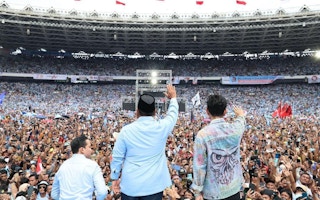Indonesia is no stranger to overly ambitious targets. While the government currently targets its primary energy mix to consist of 23 per cent renewable energy (RE) by 2025 or 44 per cent by 2030, Indonesia is falling behind, at only 13 per cent RE in 2023. Given this, the National Energy Council (DEN) has suggested lowering its RE target to a more realistic 17 to 19 per cent by 2025.
The stark financing gap for Indonesia’s green transition is partly to blame for this huge disparity between targets and reality. With Indonesia’s Just Energy Transition Partnership (JETP) pledging an initial commitment of US$20 billion, the total estimated transition cost for the on-grid power sector is at least US$97.1 billion between 2023 to 2030 and US$580.3 billion between 2023 to 2050. It did not help when RE investment in 2023 reached its lowest point in the last six years. The government cited financial closure challenges in project management, procurement delays, and social opposition from local communities, especially in geothermal projects, as the main problems.
It is crucial for Indonesia to redirect its public financial flows due to the heavy subsidies for fossil fuels compared to minimal incentives for RE. From 2016 to 2020, over 90 per cent of support measures in the energy sector favoured fossil fuels, while less than one per cent went towards RE. Gradually shifting subsidies to clean energy and introducing a carbon tax can signal the government’s commitment to transitioning and reduce RE investment risks for the market. Reallocating subsidies, coupled with a carbon tax, can help to surmount roadblocks to RE development. Political will is key. Removing consumer-side subsidies (for fuel and electricity) will face public resistance, while eliminating producer-side subsidies will encounter opposition from the strong fossil fuel industry, particularly coal.
Generally, such non-populist policies pose risks for vote-seeking politicians. Each presidential candidate included Indonesia’s energy transition challenges in his proposed policy programme. All three committed to increasing Indonesia’s RE share but differ in various aspects. In the authors’ view, none go far enough to ensure Indonesia’s green transition.
On RE and net zero emission (NZE) targets, the Anies Baswedan-Muhaimin Iskandar (AMIN) campaign was the only one that mentioned a commitment to “NZE 2060”. Muhaimin was the only vice-presidential candidate who criticised the current government’s plan to lower the RE target. Team AMIN committed to gradually reaching zero emissions in the power sector but did not mention a target year, relying on diversification (read: bioenergy, geothermal, large hydro, wind, hydrogen, and solar sources).
Prabowo Subianto-Gibran Rakabuming Raka emphasised national security defence, including through self-sufficiency in energy. They are focused on achieving Indonesia’s RE share through developing biodiesel and bio-aviation fuel (from palm oil), and bioethanol (from sugarcane and cassava), targeting a successful B50 biodiesel programme and E10 ethanol blend by 2029. They promise a prospect of five million new green jobs but seem to rely more on bioenergy to make up the primary energy mix instead of power generation. Yet there are sustainability concerns when bioenergy comes to market, especially when it comes from key source feedstocks and is generated from unsustainable practices of deforestation.
The Ganjar Pranowo-Mahfud MD campaign mentioned an RE target of 25 to 30 per cent by 2029, which seems high (as the current regime sees this as unrealistic and has failed to achieve even half of it so far). They commit to lower emissions but with no set target year. All three candidates committed to a gradual phase-down of existing fossil fuel-based power plants to be replaced with RE power plants. Still, only Ganjar-Mahfud specifically mentions not building more coal-powered plants. On paper, Ganjar-Mahfud appear the most committed to the coal phase-down but will face the same complications as their predecessors.
“
Whoever becomes Indonesia’s next president, fundamental changes to the country’s fiscal policy and more finetuned energy incentives are necessary to decarbonise its energy sector.
On financing, Team AMIN focus on providing incentives and innovative financing schemes, aiming to secure more affordable foreign funding by leveraging competitive interest rates and exploring opportunities in carbon trading. They plan to offer financial incentives and business support for the green sector and to encourage the production and purchase of low emission goods and services. Team AMIN envisages that RE development will be incentivised and non-RE discouraged, aligned with their objective of redirecting financial flows from fossil fuel-intensive sectors. They plan to levy a carbon tax but gave no further explanation as to whether or how they plan to increase the current rate, which is already among the lowest in the world.
Prabowo-Gibran talked about revising regulations hindering new investment in the new and RE sector and improving incentives to encourage the exploration of new energy sources. They wish to continue Indonesia’s targeted energy subsidy programme, although they do not mention improved targeting. Subsidy mistargeting in Indonesia is among the main reasons why energy subsidies strain the state budget.
Ganjar-Mahfud elaborated on accelerating Indonesia’s transition to RE to reach 25 to 30 per cent by 2029 but did not explain how to address the funding gap. They mention incentives or disincentives such as carbon taxes, tax relief for utilising RE and energy conservation, and tax reduction and reform of energy subsidies for using clean and environmentally friendly technologies. They plan to prioritise the downstreaming of coal but imply even more subsidies for coal and increasing the coal domestic market obligation (DMO).
They also discuss improving fiscal and non-fiscal incentive patterns for investors in the fossil energy sector and deploying “clean” technology in using coal and crude oil. This is considered a false solution; this contradictory plan to subsidise both clean and fossil fuel technologies calls into question their commitment to transitioning and which technology would be prioritised.
Although it will be neither straightforward nor politically popular, gradually phasing out subsidies for fossil fuels is a key initial step towards addressing Indonesia’s financing gap for energy transition. Unfortunately, none of the candidates mentions this commitment.
Whoever becomes Indonesia’s next president, fundamental changes to the country’s fiscal policy and more finetuned energy incentives are necessary to decarbonise its energy sector. It is difficult to see how the next president can bring about that change since none of the candidates proposed sufficiently progressive measures in their vision and mission statements. Despite pressing climate change concerns, the environment is sidelined during each election in the pursuit of votes.
Anissa R. Suharsono is an independent researcher focusing on climate and energy. She is based in Jakarta.
Yanuar Nugroho is a visiting senior fellow at ISEAS – Yusof Ishak Institute. He was the former deputy chief of staff to the President of Indonesia from 2015 to 2019.
This article was first published by ISEAS – Yusof Ishak Institute as a Fulcrum commentary.
Read our analysis on the climate credibility of each of Indonesia’s presidential candidate here.












